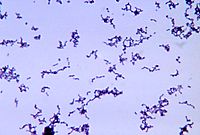
Photo from wikipedia
Suckling calves are prone to Cryptosporidium infection. The variable degree of clinical disease is influenced by keeping conditions and immune status of the host, but diversity of isolate virulence may… Click to show full abstract
Suckling calves are prone to Cryptosporidium infection. The variable degree of clinical disease is influenced by keeping conditions and immune status of the host, but diversity of isolate virulence may also contribute. The aim of the current study was to evaluate the cytopathogenic effects of 26 C. parvum field isolates by using a MTT assay in HCT-8 cell monolayers. Cell viability of monolayers inoculated with oocysts of the field isolates varied considerably with values of 17.7% (± 5.1%) to 99.5% (± 7.1%). A standard deviation of 18.6% was detected for cell viability of the in house reference strain, which were tested alongside in every assay. Field isolates were grouped in three categories of cytopathogenicity. Probably the length of storage has an effect on the level of the cell destruction category detected post infection in vitro. The applied tool may help to better understand the variable course of cryptosporidiosis in the field.
Journal Title: Veterinary parasitology
Year Published: 2019
Link to full text (if available)
Share on Social Media: Sign Up to like & get
recommendations!